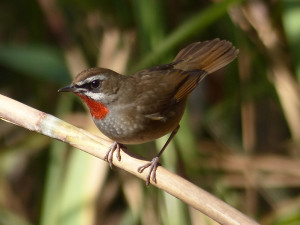
For the last seventeen days I havebeen in Northern and Central Thailand. This year we saw over 470 species in the 17 days of the trip with another 5 leader-seen-only and 10 heard only species recorded despite some unusual weather conditions resulting in some difficult birding at several locations. Some personal highlights included Rusty-naped Pitta, Green Cochoa, Silver-eared Mesia, Baer’s Pochard, Falcated Duck, Jerdon’s Bushchat, Black-headed Bunting, Red-headed Bunting, Pied Harrier, Western Marsh Harrier, Pygmy Wren Babbler, Rufous-throated Partridge, Black-headed Woodpecker, Chestnut Thrush, Grey-sided Thrush, Blue Pitta, Silver Pheasant, Siamese Fireback, Great Hornbill, Mrs Hume’s Pheasant, Black-and-red Broadbill, Long-tailed Broadbill, Black-and-yellow Broadbill, Red-headed Trogon, Collared Falconet, Great Slaty Woodpecker, Heart-spotted Woodpecker, Asian Dowitcher, Spoon-billed Sandpiper, Steppe Gull, Red-bearded Bee-eater, Pallas’s Grasshopper Warbler, Baillon’s Crake and Spot-billed Pelican.
Starting on 11th February we visited Northern Thailand first in order to miss the poor air quality that can build up in early March, but with this being a very dry year there was already a haze in the northern skies and the cool weather was already over but we were still able to find a lot of good birds;
Doi Ang Kang
We had a short stay at this beautiful location and started our trip with a mega sighting – Rusty-naped Pitta at just a few feet away along with a gang of wonderful Silver-eared Mesias, a male Black-throated Thrush, Hill Blue Flycatcher, Large Niltava and White-tailed Robin, such a great start to the tour.
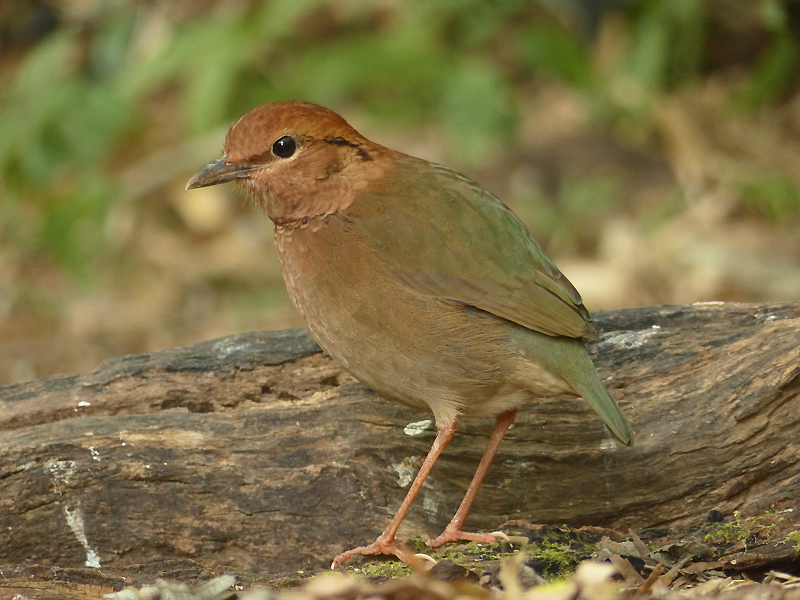 Rusty-naped Pitta by Nick Upton
Rusty-naped Pitta by Nick Upton
A very nice morning at Doi Ang Kang provided us with an excellent introduction to northern species too with an abundance of birds on a hill slope as the first morning sun hit it; Scarlet-faced Liocichla, Spectacled Barwing, Giant Nuthatch, Japanese Tit, Long-tailed Minivet, Common Rosefinch, Buff-throated Warbler, Striated Bulbul and many more. A brief trip to the Thai – Myanmar border is always an interesting experience and great photo opportunity and a male Daurian Redstart plus Yellow-streaked Warbler provided out only sightings of these species on the tour.
Doi Lang
This most northerly of the mountains we regularly visit always provides a lot of excellent sightings with the photo stakeouts giving us close up views of Himalayan Bluetail, Red-flanked Bluetail, Ultramarine Flycatcher, Scarlet-faced Liocichla, Large Niltava, White-bellied Redstart, Slaty-blue Flycatcher, Hill Prinia, Japanese Tit, Rufous-bellied Niltava, White-browed Scimitar Babbler, White-gorgetted Flycatcher, Spectacled Barwing and Silver-eared Laughingthrush. Getting views of birds like this, out in the open and at close range is what makes for a memorable trip and enables birders to really appreciate the details of the bird’s plumage as well as being able to witness some amusing behaviour; an overweight Large Niltava breaking a perch and a very territorial male Himalayan Bluetail were memorable on this trip. Siberian Rubythroat is a wonderful bird and everyone was overjoyed to see several stunning males at just a few feet away
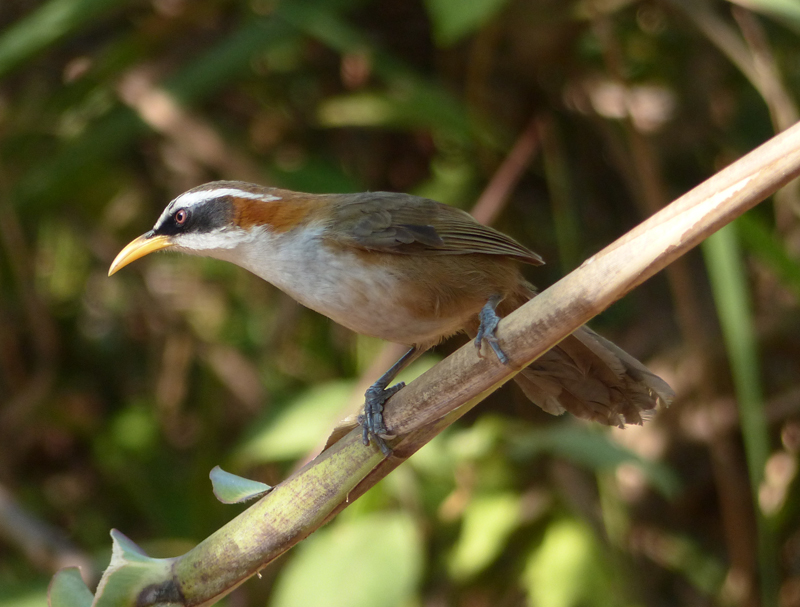 White-browed Scimitar Babbler by Nick Upton
White-browed Scimitar Babbler by Nick Upton
 Siberian Rubythroat by Nick Upton
Siberian Rubythroat by Nick Upton
We made a special effort to see some particular species and it was very pleasing to get great views of Mrs Hume’s Pheasant, Mountain Bamboo Partridge, Rusty-cheeked Scimitar Babbler and White-browed Laughingthrush feeding on the road in the early morning. Slender-billed Oriole proved hard to see, although we eventually got good ‘scope views and we also found Crested Bunting as well as Chestnut Bunting – with buntings being scarce in Thailand these days both species were good sightings.
Leaf Warblers can be seen well at Doi Lang too and we got close up sightings of Buff-barred, Davison’s as well as Chinese Leaf Warblers all of which presented themselves for photographs and we were also able to see both Bianchi’s & Marten’s Warblers here, identifying them on call.
Chiang Saen
A day at this area of wetlands got us a huge day total of birds with the undoubted highlight being the c200 Harriers that came in to roost at the end of the day. Most of the group were anticipating male Pied Harriers most and they were not disappointed with probably close to 100 of these wonderful raptors arriving, but for me the single male Western Marsh Harrier was special, being a real rarity in Thailand.
Finding the male Baer’s Pochard that had been reported was exciting too, particularly as it had all the characteristics of a genuine bird in contrast to some of the birds that have been photographed at Beung Boraphet which would appear to be hybrids. Also spotting the male Falcated Duck was a bonus! Other good birds here included several Striated Grassbirds, excellent views of Slaty-breasted Rail, Grey-headed Lapwing, Small Pratincole, Red Avadavat and Citrine Wagtail.
Thatorn
Wetland sites seem to have provided much of the best birding in Thailand over the last few months and at Thatorn we continued our run of finding rare species at this location. Large amounts of habitat destruction and agricultural intensification were worrying though and with a large amount of land for sale in a great location the suggestion was made to the BCST in a posting on Facebook that it would be interesting to investigate the possibility of creating a reserve there; alas there has been no response to this from them.
Finding Jerdon’s Bushchat was pleasing as well as a group of Buntings that included Black-headed, Yellow-breasted and the pair of Red-headed Buntings that I first discovered in January; this time I obtained a poor quality photograph and this generated more interest in the location than back in January!
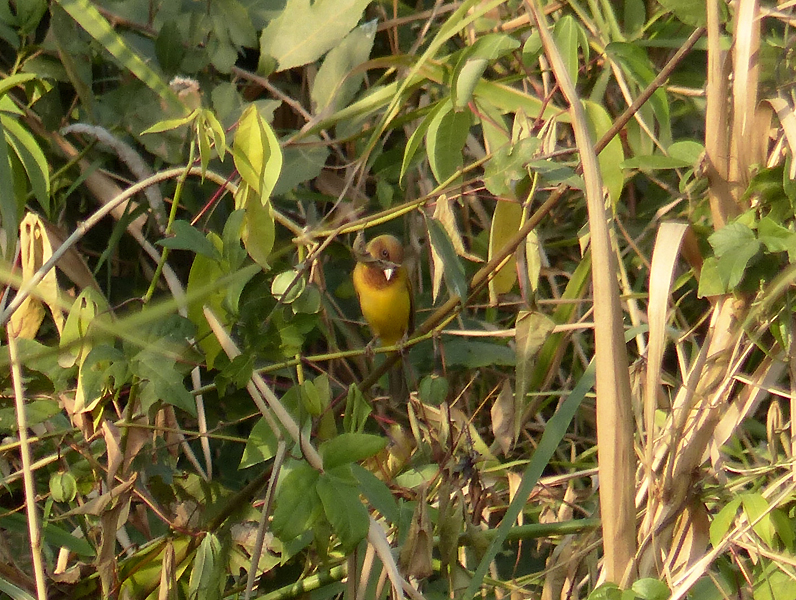 Red-headed Bunting by Nick Upton
Red-headed Bunting by Nick Upton
Burnt vegetation here was a foraging ground for some numbers of Siberian Rubythroats as well as a Bluethroat and many Dusky Warblers. On the river we saw several Small Pratincoles and at our accommodation everyone saw a Collared Scops Owl and I located a Barn Owl which was making a lot of noise next to my room.
Doi Inthanon
On Thailand’s highest mountain we had some of the best birding of the trip with good abundance of flocking species as well as some difficult to find birds. Abundance of birds at the summit was perhaps the highest I have ever witnessed with huge numbers of Sunbirds and White-eyes feeding on flowering trees as well as a beautiful Chestnut Thrush. We were also able to photograph Grey-sided Thrush in a fruiting tree with a major influx of this scarce species this year in Thailand. The summit also provided us with great views of Rufous-throated Partridge which approached us to within a three feet, Sbowy-browed Flycatcher, Green-tailed Sunbird, Ashy-throated Warbler, Chestnut-tailed Minla, Dark-sided Thrush, Pygmy Wren Babbler as well as a brief sighting of a pair of Northern White-crowned Forktails.
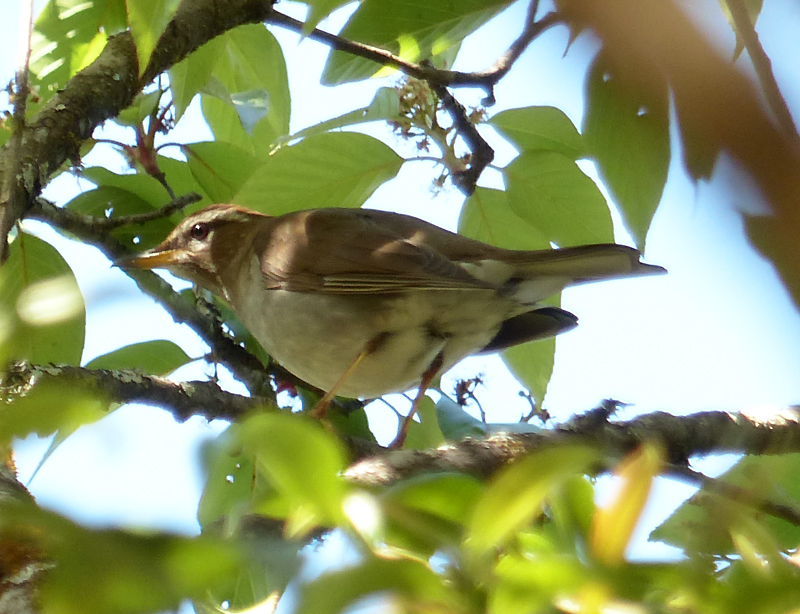 Grey-sided Thrush by Nick Upton
Grey-sided Thrush by Nick Upton
Further down the mountain we photographed a male Blue-fronted Redstart thanks to a tip off and had some great birding with a flock that included Clicking Shrike-babbler, Hume’s Treecreeper, Rufous-backed Sibia, Yellow-cheeked Tit, Silver-eared Mesia, Chinese Leaf Warbler and many others while in pine trees we found Hume’s Leaf Warbler and a nice male Vivid Niltava as well as our only Black Bulbuls of the trip – unusual as this species is usually abundant. We also saw our only White-headed Bulbuls of the tour at this location; seen in great light they were one of the highlights of a morning on Doi Inthanon. However, it was a superb Green Cochoa which was the highlight of the mountain for me. I had played some calls and received a distant response early one morning but later in the day the calls were coming form much closer and with two birds vocalizing a little call playback brought on of them into sight where it sat for some minutes.
White-capped Water Redstart, Plumbeous Redstart, Black-headed Woodpecker and 3 stunning Collared Falconets at the pre-roost perch were also great birds at this popular location.
Wat Praphuttabaht Noi
This temple site in Saraburi province is visited for Limestone Wren Babbler of the calcicola subspecies and we found a few of these vocal birds quite easily including one that was feeding in a flowering tree. We spent a short time here photographing the scenery as well as a Radde’s Warbler and Eurasian Hoopoe.
Khao Yai
This national park has some fantastic habitat and species to see but suffers from high visitor numbers and poor management. Birding here can be very frustrating at times but every year we see some fantastic birds which keeps us coming back. Perseverance got us Silver Pheasant and Siamese Fireback as well as a male Blue Pitta and some fruiting trees gave us some great birds and photographic opportunities – Green-eared Barbet, Golden-crested Myna, Moustached Barbet, Eye-browed Thrush, White-crested Laughingthrush, Great Hornbill and many others.
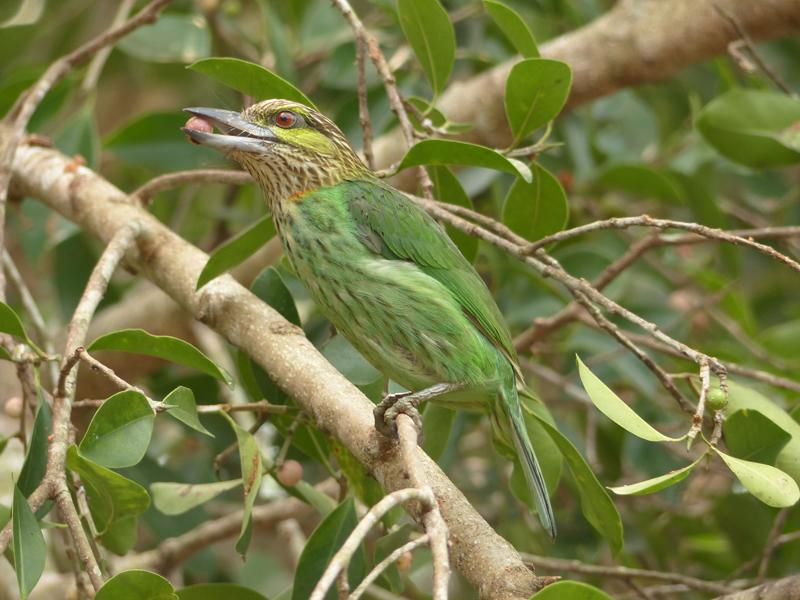 Green-eared Barbet by Nick Upton
Green-eared Barbet by Nick Upton
The old stakeout behind the campsite toilets were interesting too with Abbott’s Babbler, male Siberian Blue Robin, Puff-throated Babbler, White-rumped Shama and a couple of stunning Orange-headed Thrushes although only I saw the Scaly Thrush there.
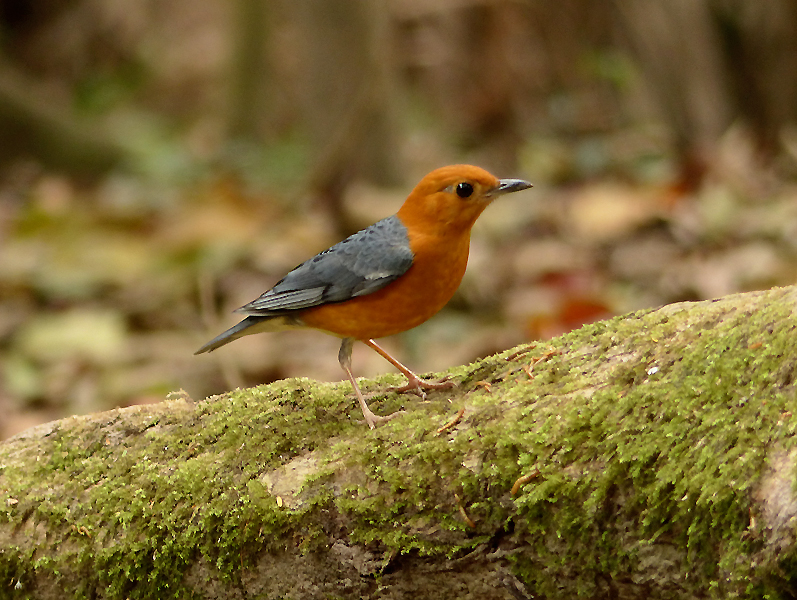 Orange-headed Thrush by Nick Upton
Orange-headed Thrush by Nick Upton
Khao Yai has a habit of turning up brightly coloured and showy species and we managed to find a good number of these with Red-headed Trogon, Van Hasselt’s Sunbird, Crimson Sunbird, Green Magpie, Banded Broadbill, Banded Kingfisher, Rufous Woodpecker, Laced Woodpecker and a pair of Black-and-buff Woodpeckers, all wonderful birds.
We also did well for mammals at this site with everyone’s favourite – Asian Elephant – putting in an appearance as well as Variable Squirrel, Sambar, Red Muntjac, Pig-tailed Macaque, East Asian Porcupine and some wonderful White-handed Gibbons feeding in a fruiting tree next to the road.
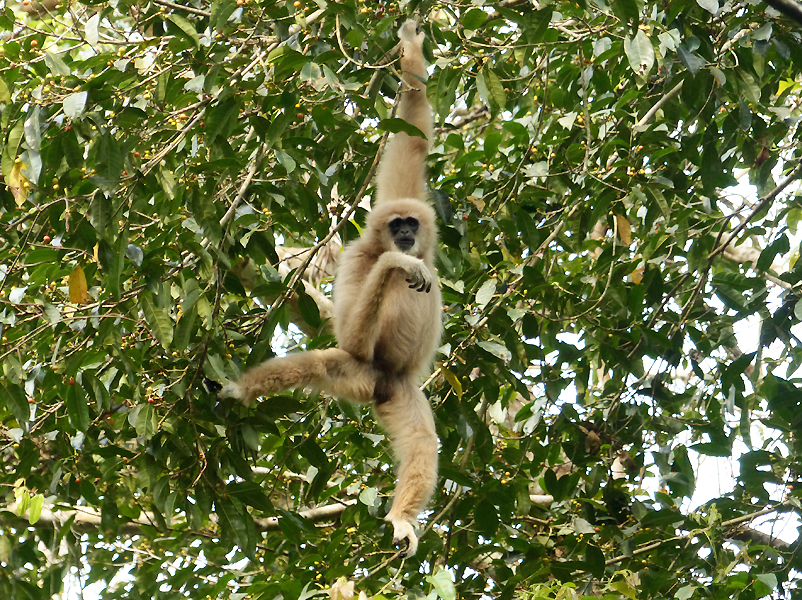 White-handed Gibbon by Nick Upton
White-handed Gibbon by Nick Upton
Petchaburi Wetlands
This part of the trip is always highly anticipated and this year it delivered just as hoped for with excellent views of 3 Spoon-billed Sandpipers on the salt farms. Unfortunately it was mentioned to me that local landownership has changed at that the new owner is thinking of closing the site to the public because of the poor behaviour of some visiting bird groups. Walking on small, easily-damaged soil bunds, driving too fast and even aggressive behaviour from the guide of one well-known visiting bird tour company were mentioned as reasons for the possible closure of the site. This area is privately owned so visitors should please respect this and behave appropriately.
On a more positive note we were able to find a total of 102 Nordmann’s Greenshank, 3 Far Eastern Curlews, 1000s of Great Knot, 200+ Terek Sandpipers, 5 Dunlin, 1 Little Stint, 10+ Red Knot, 5 Red-necked Phalaropes, 6 Slender-billed Gulls, 10+ Malaysian Plovers, 2 Chinese Egrets, 2 White-faced Plovers, 5 Pallas’s Gulls as well as all the commoner wader species. Eventually we managed to find 3 Asian Dowitchers as well as 1 Spot-billed Pelican and there was also a gull at the sand spit which seems increasingly like a Steppe Gull, barabensis, after much research and talking to people familiar with this taxon. Several others have suggested that this bird is heuglini but every plumage and structural feature point towards barabensis as does the moult which sees the bird in a white-headed appearance in late February next to Heuglin’s (taimyrensis) which still have heavy streaking on the neck and head. The below photo was taken in January when the bird had some thin streaking confined to the lower neck, consistent with barabensis, rather than the heavy streaking of heuglini and taimyrensis. The deep yellow of the bare parts, rounded crown, small eye, bill structure and 4-coloured pattern and shade of grey on the back and wings (some have said that this bird is too dark for barabensis but a look at photos in articles on the taxon reveal this bird to be consistent with “classic” barabensis colouration).
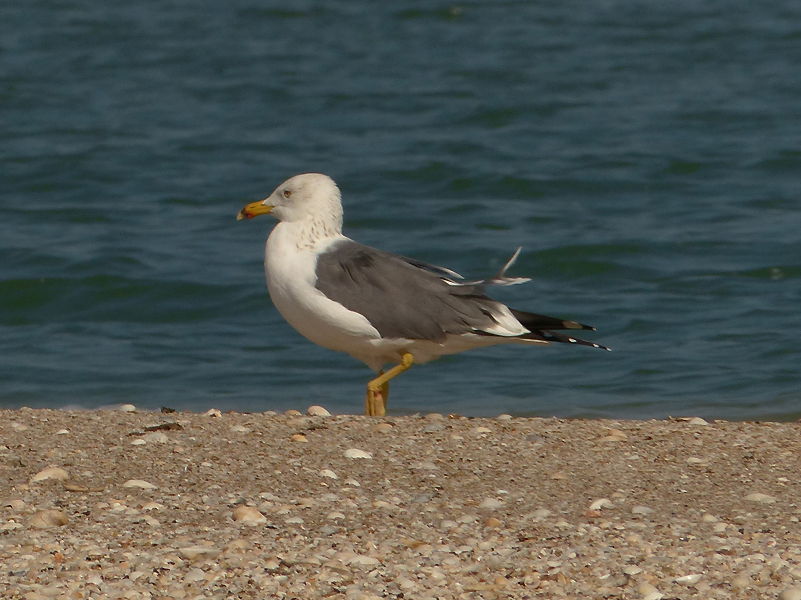 Probable “Steppe” Gull by Nick Upton
Probable “Steppe” Gull by Nick Upton
In the Petchaburi area we had some great birding in the rice fields and freshwater pools with highlights being Pallas’s Grasshopper Warbler, Stork-billed Kingfisher, Pink-necked Green Pigeon, Freckle-breasted Woodpecker, White-browed Crake, Baillon’s Crake, Cotton Pygmy Goose, Oriental Pratincole, Oriental Darter, Asian Golden Weaver, Streaked Weaver, Rudyy-breasted Crake, White-shouldered Starling, Indian Nightjar and Purple-backed Starling.
Kaeng Krachan
Our last birding site of the tour was Kaeng Krachan national park which always turns up a lot of spectacular birds and this year was to be no different despite incredibly dry conditions, a morning of drizzle and high winds throughout, all of which made birding tricky. Our first stop in the forest was a success with Great Hornbill, Oriental Pied Hornbill, Green-eared Barbet, Blue-eared Barbet and Asian Fairy Bluebird all on a fruiting tree. Great Slaty Woodpeckers and Heart-spotted Woodpeckers were excellent birds as was the Black-thighed Falconet we ‘scoped.
We did quite well for Cuckoos here with excellent views of Asian Drongo Cuckoo, a male Violet Cuckoo, Asian Emerald Cuckoo and a Himalayan Cuckoo too. One afternoon provided slow birding but with Orange-breasted Trogon on the nest, Red-bearded Bee-eater just a few feet away and Red-throated Barbet no one was complaining, particularly after we called in and ‘scoped a Brown Boobook; just a shame the Crested Jays did not perform a little better.
We had already seen three species of Broadbill on this trip and we topped this off with an excellent pair of Black-and-red Broadbills and a very close-up Black-and-yellow Broadbill. Tickell’s Brown Hornbill was another good find along with everyone managing to get onto a pair of Scaly-breasted Partridges.
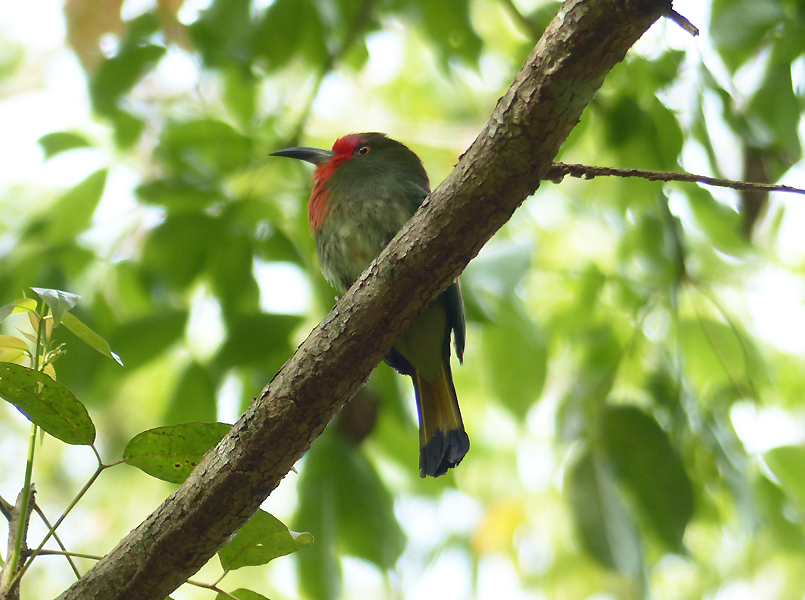 Red-bearded Bee-eater by Nick Upton
Red-bearded Bee-eater by Nick Upton
An afternoon at Lung Sin Waterhole provided some great birds and more variety than normal. A pair of Kalij Pheasants were a favourite of the crowd but Bar-backed Partridge, Large Scimitar Babbler, Lesser & Greater Necklaced Laughingthrushes, Racket-tailed Treepie were also nice. A Grey-headed Woodpecker also turned up as did a Banded Bay Cuckoo, Greater Racket-tailed Drongo, Emerald Dove and the grand finale was provided by a Green Magpie.
In the forest several primate species were fun to watch with a troop of Stump-tailed Macaques foraging around our vehicle and Dusky Langurs as well as White-handed Gibbons in fruiting trees near Bang Krang campsite on our final morning before heading back to Bangkok.
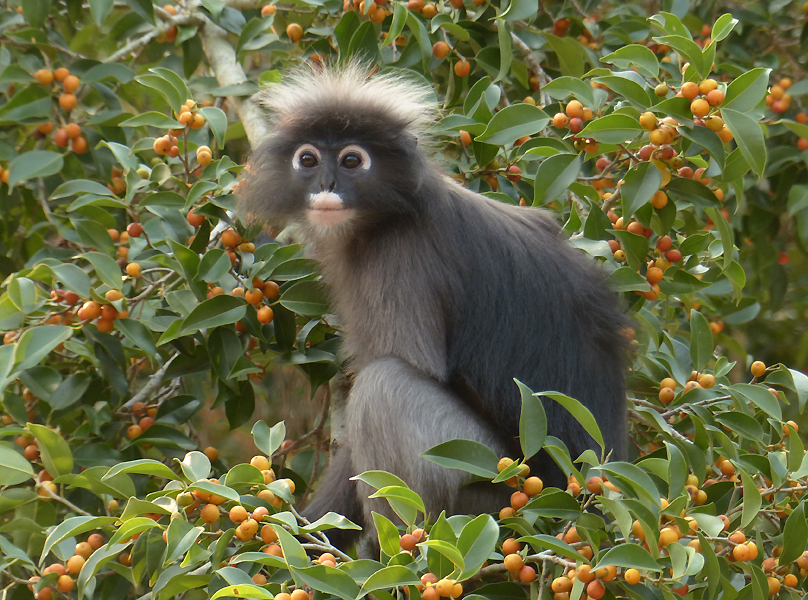 Dusky Langur by Nick Upton
Dusky Langur by Nick Upton
 Stump-tailed Macaque by Nick Upton
Stump-tailed Macaque by Nick Upton


 February 28th, 2016
February 28th, 2016  Nick
Nick  Posted in
Posted in  Tags:
Tags: 










